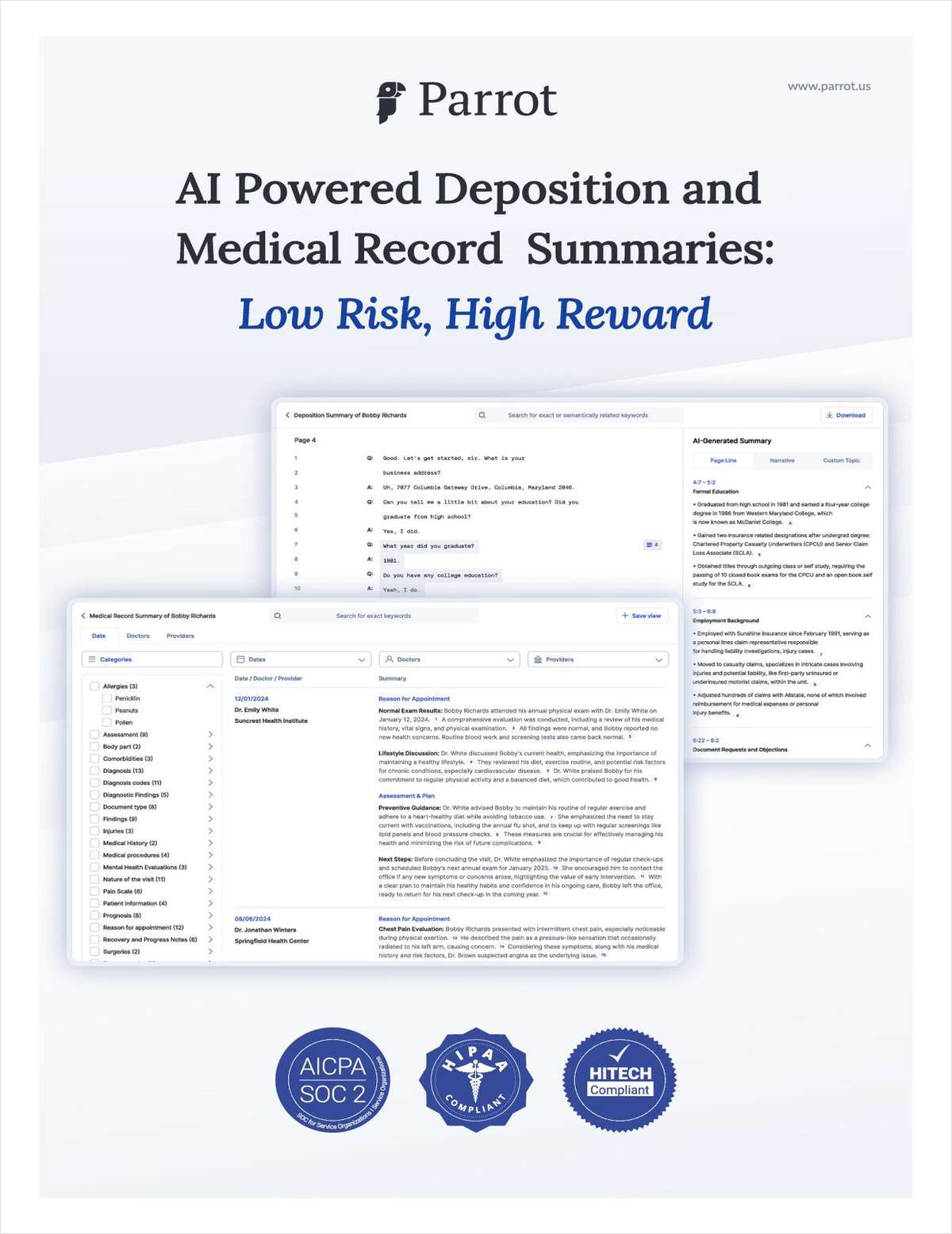Linking Content Into the Client Journey: Why Content Experience Matters
One of the most effective components of legal marketing is thought leadership content. With today's available palette of media tools, law firms are able to design, build and customize the content that their client's experience like never before. Ensuring that this "content experience" is profound and impactful is a necessary and critical endeavor.
February 12, 2020 at 04:18 PM
8 minute read
This article appeared in Marketing the Law Firm, an ALM/Law Journal Newsletters publication reporting on the latest, and most effective, strategies for Chief Marketing Officers, Managing Partners, Law Firm Marketing Directors, Administrators and Consultants.
Whatever the size of the law firm, small, midsize or Big Law, marketing's goal is to engage your target audiences and demonstrate your firm to be the authoritative leader in providing the solutions they should choose. As communications expert Seth Godin describes it: "Marketing is the act of telling a story so vivid and true that people who hear it want to tell other people." One of the most effective components of legal marketing is thought leadership content. With today's available palette of media tools, law firms are able to design, build and customize the content that their client's experience like never before. Ensuring that this "content experience" is profound and impactful is a necessary and critical endeavor.
What Is Content Experience?
By definition, content experience is the comprehensive digital interactions someone has with a firm's subject matter and the impression it leaves on them. It is comprised of a three-step approach — presentation, structure and engagement.
A law firm client's journey needs to be understood as the entire pathway delivering all manner of impressions. From a response to a request for proposal, to the welcome packet at the point of engagement, to an end of matter survey, to a robust client feedback program, all digital content along this journey must be nurtured, measured, and modified at each step. This can include anything from signing up for access to a white paper, an on-demand CLE or the results to a targeted survey.
Why should marketers devote energies to create a content experience in the client journey? There are few ways to develop goodwill and trust with a potential client that are more effective than providing useful, value-adding information that is easy to find. When a client actively seeks information to help begin a problem-solving process, mediocrity must be pushed aside. Law firms need to do more than summarize or regurgitate baseline information. Many law firm insiders have experienced how difficult it can be to fashion valuable content and make it available timely to its desired audience. Familiar is the mantra that law firms do not have the resources to "feed the content beast as all employees are overloaded." While this is not untrue, the effort to provide good thought leadership is essential growing your client base. Perhaps this statistic will resonate with law firms: It can take 12 positive experiences to repair the damage of a negative experience, if it can be repaired at all. Clients seek law firms to serve as their trusted advisors. Building trust requires effort. Any energy devoted to a content experience will help to enhance your law firm's value. It will help showcase why your firm is positioned to handle a new dilemma or issue facing your client or the marketplace.
Creating a Meaningful Content Experience
Conduct a Content Audit
As a precursor to implementing a content experience, marketers should conduct a content audit. This can be performed in something as simple as a spreadsheet or conducted through the use of a variety of tools. Without a dedicated and thoughtfully developed campaign, a significant percentage of potential content will not be properly curated across the appropriate digital channels (such as websites and social media platforms) and will remain underutilized or not utilized. It is important to understand your firm's current content assets, to document and map the respective content in the appropriate format, determine the practice/industry/service groups where the content can be located, consumed, and utilized both internally, and by clients and prospects. Next, you must endeavor to ensure the content is up-to-date, fresh and authentic. Finally, a robust content strategy requires mapping the content plan — its workflow, calendar/timing, promotion and measurement.
A Content Strategy and Content Plan Alone Are Not Enough
Content experience requires driving traffic to a firm's digital real estate, and creating an informed and engaged audience, on a regular and repeated basis. Building and maintaining a firm's reputation requires presenting updates and potential solutions to your client's questions on a continual and repeated basis. Continued engagement is pivotal in nurturing clients and identifying new targets.
Just as a photojournalist working on a narrative needs a photo editor to implement sequencing that enables the photos to connect to a purpose and make a good book great, content experience has a three-step methodology.
Undertaking a three-pronged approach and sustaining it will provide you with the most value for the content experience.
Prong One: Presentation. Words matter, especially in the legal profession. The proper terms can potentially make all the difference in deciding a matter. The words that comprise our navigation, the time we spend on SEO optimization and visual design, help bolster the overall presentation. With voice-search usage becoming more and more powerful with each passing year, investing time now to enhance your SEO will be beneficial. Ensure search terms and language are consistent across all channels and within brand guidelines. Consider conversational, long-tail, semantic phrases that are in the style of voice search queries. Also, think like a journalist. What differentiates your piece from another? The headlines and sub-headers of each written piece should be crafted carefully, just as are the titles and sections of webinars, podcasts and videos. Moreover, it is important to utilize photos or infographics to strategically capture new audiences and help hone in on important themes.
Prong Two: Structure. Clients and prospects should be able to find what they need in an intuitive fashion. Consider grouping content by topic or industry as opposed to by format (such as white paper, video or blog). People do not generally search sites by the way in which they consume information. An example might be when searching for something and google generates four pages of results, the likelihood of scanning past the first few results is limited. An individual visiting the site should not have to click six times to find the requested information. More than two clicks may result in a disenfranchised user who will seek to find the information elsewhere, possibly on a competitor's site. A client survey can shed great light on how your audience needs to have content packaged and organized. Also, find out where are clients and prospects searching for the information. Is it in a different area than where it currently resides, such as a practice page vs. industry grouping? Is there value in turning an important white paper into a podcast? This is similar to User Experience and requires resources dedicated to Web analytics. That is the primary way to know if people are coming to your site and what they are doing once they are there. Looking at Web traffic as to where it comes from, where it goes at the point of entry and what people search for most can tell you something is hard to find or it's a popular topic.
Prong Three: Engagement. It is important to note whether the content compelled a level of action in the market. What subject matter expertise are clients looking for? Law firms have sophisticated business intelligence and practice management tools that assess profitability, team productivity, and legal operations to help drive growth. There are a myriad of marketing tools to help inform the content experience. These range from heat maps to assess targeted Web behaviors to boosting two-way engagement, nurturing leads and tracking relevant issues in the marketplace with listening tools. All require data analyses of your digital properties. Perhaps your firm's client base consumes information via podcasts when traveling to and from work. Understanding these analytics can change your choices. It enables law firms to help answer the questions both clients and prospects are seeking.
Next Steps
The success of your client's content experience can be measured. Gather your marketing, business development, communications professionals, and subject matter experts after you conduct your content audit to ensure you are engaging clients and nurturing new relationships. Determine where the content experience will most benefit your marketing goals. Meet your target audiences where they are and create something relatable and meaningful. Double down on what is resonating with your audiences to keep them engaged. Creating valuable content and making it findable will increase your chances for success.
*****
Jennifer S. Bankston has spent over 20 years spearheading strategic initiatives for law firms and other industries. She is president of Bankston Marketing Solutions and can be reached at bankstonmarketingsolutions.com.
This content has been archived. It is available through our partners, LexisNexis® and Bloomberg Law.
To view this content, please continue to their sites.
Not a Lexis Subscriber?
Subscribe Now
Not a Bloomberg Law Subscriber?
Subscribe Now
NOT FOR REPRINT
© 2025 ALM Global, LLC, All Rights Reserved. Request academic re-use from www.copyright.com. All other uses, submit a request to [email protected]. For more information visit Asset & Logo Licensing.
You Might Like
View All
'If the Job Is Better, You Get Better': Chief District Judge Discusses Overcoming Negative Perceptions During Q&A

Scammers Target Lawyers Across Country With Fake Court Notices

Unlocking Your Lawyers' Rainmaking Potential: A Coaching Guide

Trending Stories
- 1Uber Files RICO Suit Against Plaintiff-Side Firms Alleging Fraudulent Injury Claims
- 2The Law Firm Disrupted: Scrutinizing the Elephant More Than the Mouse
- 3Inherent Diminished Value Damages Unavailable to 3rd-Party Claimants, Court Says
- 4Pa. Defense Firm Sued by Client Over Ex-Eagles Player's $43.5M Med Mal Win
- 5Losses Mount at Morris Manning, but Departing Ex-Chair Stays Bullish About His Old Firm's Future
Who Got The Work
J. Brugh Lower of Gibbons has entered an appearance for industrial equipment supplier Devco Corporation in a pending trademark infringement lawsuit. The suit, accusing the defendant of selling knock-off Graco products, was filed Dec. 18 in New Jersey District Court by Rivkin Radler on behalf of Graco Inc. and Graco Minnesota. The case, assigned to U.S. District Judge Zahid N. Quraishi, is 3:24-cv-11294, Graco Inc. et al v. Devco Corporation.
Who Got The Work
Rebecca Maller-Stein and Kent A. Yalowitz of Arnold & Porter Kaye Scholer have entered their appearances for Hanaco Venture Capital and its executives, Lior Prosor and David Frankel, in a pending securities lawsuit. The action, filed on Dec. 24 in New York Southern District Court by Zell, Aron & Co. on behalf of Goldeneye Advisors, accuses the defendants of negligently and fraudulently managing the plaintiff's $1 million investment. The case, assigned to U.S. District Judge Vernon S. Broderick, is 1:24-cv-09918, Goldeneye Advisors, LLC v. Hanaco Venture Capital, Ltd. et al.
Who Got The Work
Attorneys from A&O Shearman has stepped in as defense counsel for Toronto-Dominion Bank and other defendants in a pending securities class action. The suit, filed Dec. 11 in New York Southern District Court by Bleichmar Fonti & Auld, accuses the defendants of concealing the bank's 'pervasive' deficiencies in regards to its compliance with the Bank Secrecy Act and the quality of its anti-money laundering controls. The case, assigned to U.S. District Judge Arun Subramanian, is 1:24-cv-09445, Gonzalez v. The Toronto-Dominion Bank et al.
Who Got The Work
Crown Castle International, a Pennsylvania company providing shared communications infrastructure, has turned to Luke D. Wolf of Gordon Rees Scully Mansukhani to fend off a pending breach-of-contract lawsuit. The court action, filed Nov. 25 in Michigan Eastern District Court by Hooper Hathaway PC on behalf of The Town Residences LLC, accuses Crown Castle of failing to transfer approximately $30,000 in utility payments from T-Mobile in breach of a roof-top lease and assignment agreement. The case, assigned to U.S. District Judge Susan K. Declercq, is 2:24-cv-13131, The Town Residences LLC v. T-Mobile US, Inc. et al.
Who Got The Work
Wilfred P. Coronato and Daniel M. Schwartz of McCarter & English have stepped in as defense counsel to Electrolux Home Products Inc. in a pending product liability lawsuit. The court action, filed Nov. 26 in New York Eastern District Court by Poulos Lopiccolo PC and Nagel Rice LLP on behalf of David Stern, alleges that the defendant's refrigerators’ drawers and shelving repeatedly break and fall apart within months after purchase. The case, assigned to U.S. District Judge Joan M. Azrack, is 2:24-cv-08204, Stern v. Electrolux Home Products, Inc.
Featured Firms
Law Offices of Gary Martin Hays & Associates, P.C.
(470) 294-1674
Law Offices of Mark E. Salomone
(857) 444-6468
Smith & Hassler
(713) 739-1250








